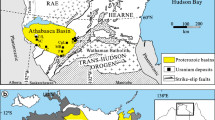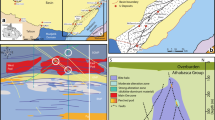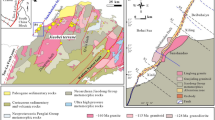Abstract
Numerical simulations were performed to examine the driving mechanisms and their relative dominance in concentrating hydrothermal ore-forming fluid flow in the Chanziping ore district, South China. A numerical scheme was employed to provide realistic strain-dependent porosity and permeability during tectonic deformation. The results indicate that the buoyancy resultant from typical geothermal gradients alone during tectonically quiescent periods could not focus ore-forming fluids to the trap area for U precipitation. The extensional tectonic deformation in the late Yanshanian-early Himalayan period caused a broad downwelling flow in the red sandstone, channeling downwards along the regional fault to mix with the basement-derived upwelling reducing fluid driven by the buoyancy force. This leads to the ore genesis in the black shale below the fracture zone. The compressive deformation in the Indo-Chinese epoch would have essentially squeezed the basinal fluid and basal brine out of the basin, and hence would have been unfavorable for the formation of the Chanziping deposit. It was also observed that tectonic deformation always overwhelms the effect of buoyancy in driving hydrothermal flow, even if an extension or shortening of as little as 1% is applied.






Similar content being viewed by others
Data Availability
Numerical computation was conducted by using the commercial software package FLAC8.1. Details of the governing equations that describe the physical processes of fluid flow, heat transport and mechanical deformation, and the numerical method that implements the coupling of these processes can be found in FLAC8.1’s User Manual (Itasca, 2021). All data used in this research are tabulated in Table 1. No new data were generated or analyzed in support of this research.
References
Aghbelagh, Y. B., & Yang, J. (2017). Role of hydrodynamic factors in controlling the formation and location of unconformity-related uranium deposits: Insights from reactive-flow modeling. Hydrogeology Journal, 25, 465–486.
Bruce, M., Kreuzer, O., Wilde, A., Buckingham, A., Butera, K., & Bierlein, F. (2020). Unconformity-type uranium systems: A comparative review and predictive modelling of critical genetic factors. Minerals, 10, 738–793. https://doi.org/10.3390/min10090738
Chen, X., Huang, R., & Ying, X. (2002). Geologic-hydrogeochemical prospecting criteria and prospecting model for uranium deposits in southern Hunan and northern Guangxi. Uranium Geology, 18, 229–234.
Cui, T., Yang, J., & Samson, I. M. (2012a). Tectonic deformation and fluid flow: Implications for the formation of unconformity-related uranium deposits. Economic Geology, 107, 147–163.
Cui, T., Yang, J., & Samson, I. M. (2012b). Solute transport across basement/cover interfaces by buoyancy-driven thermohaline convection: Implications for the formation of unconformity-related uranium deposits. American Journal of Science, 312, 994–1027.
Cuney, M. (2009). The extreme diversity of uranium deposits. Mineralium Deposita, 44, 3–9.
Cuney, M., & Kyser, T. K. (2009). Recent and not-so-recent developments in uranium deposits and implications for exploration. Mineralogical Association of Canada Short Course Series, 39, 1–257.
Dahlkamp, F. J. (2013). Uranium ore deposits. Springer-Verlag.
De Veslud, C. L. C., Cuney, M., Lorilleux, G., Royer, J. J., & Jébrak, M. (2009). 3D modeling of uranium-bearing solution-collapse breccias in Proterozoic sandstones (Athabasca Basin, Canada)-metallogenic interpretations. Computers & Geosciences, 35, 92–107.
Derome, D., Cathelineau, M., Cuney, M., Fabre, C., Lhomme, T., & Banks, D. A. (2005). Mixing of sodic and calcic brines and uranium deposition at McArthur River, Saskatchewan, Canada: A Raman and Laser-Induced breakdown spectroscopic study of fluid inclusions. Economic Geology, 100, 1529–1545.
Eldursi, K., Chi, G., Bethune, K., Li, Z., Ledru, P., & Quirt, D. (2020). New insights from 2- and 3-D numerical modelling on fluid flow mechanisms and geological factors responsible for the formation of the world-class Cigar Lake uranium deposit, eastern Athabasca Basin, Canada. Mineralium Deposita, 44, 3–9. https://doi.org/10.1007/s00126-020-00979-5
Fayek, M., & Kyser, T. K. (1997). Characterization of multiple fluid events and rare-earth-element mobility associated with formation of unconformity-type uranium deposits in the Athabasca Basin, Saskatchewan. Canadian Mineralogist, 35, 627–658.
Gandhi, S. S. (2007), Significant unconformity-associated uranium deposits of the Athabasca Basin, Saskatchewan and Alberta, and selected related deposits of Canada and the world. Geological Survey of Canada, Open File 5005; Saskatchewan Industry and Resources, Open File 2007–2011.
Hobbs, B. E., Muhlhaus, H. B., Ord, A. (1990), Instability, softening and localization of deformation. In: Knipe, R.J, Rutter, E.H. (Eds.), Deformation Mechanisms, Rheology and Tectonics. Geological Society of London, Special Publication, 54, 143–165.
Hoeve, J., & Sibbald, T. I. (1978). On the genesis of Rabbit Lake and other unconformity-type uranium deposits in northern Saskatchewan, Canada. Economic Geology, 73, 1450–1473.
Hoeve, J., Rawsthorn, K., & Quirt, D. (1981). Uranium metallogenetic studies: Clay mineral stratigraphy and diagenesis in the Athabasca Group. Saskatchewan Research Council Publication, 22, 76–89.
Huang, S., Xia, Y., & Xu, W. (1985). The study of isotope geology for the genetic mechanism of Chanziping uranium deposit. Uranium Geology, 1, 10–18.
International Atomic Energy Agency (2018), Geological classification of uranium deposits and description of selected examples. IAEA-TECDOC-1842, 978-92-0-101618-8.
Itasca (2021), FLAC: Fast Lagrangian Analysis of Continua, User’s Guide, FLAC Version 8.1. Itasca Consulting Group, Inc., Minnesota.
Jefferson, C. W., Thomas, D. J., Gandhi, S. S., Ramaekers, P., Delaney, G., Brisbin, D., Cutts, C., Quirt, D., Portella, P., & Olson, R. A. (2007), Unconformity associated uranium deposits of the Athabasca Basin, Saskatchewan and Alberta. In: Goodfellow, W.D. (Ed.), Mineral Deposits of Canada: A Synthesis of Major Deposit-types, District Metallogeny, the Evolution of Geological Provinces, and Exploration Methods. Geological Association of Canada, Mineral Deposits Division, Special Publication, 5, 273–305.
Ju, M., & Yang, J. (2010). Preliminary numerical simulation of tectonic deformation-driven fluid flow: Implications for ore genesis in the Dachang District, South China. Journal of Geochemical Exploration, 106, 133–136.
Ju, M., & Yang, J. (2011). Numerical modeling of couple fluid flow, heat transport and mechanic deformation: Example from the Chanziping Ore District, South China. Geoscience Frontiers, 2, 577–582.
Kang, Z., & Liu, H. (1991). On the characteristics of metallotect features and origin of Chanziping uranium deposit. Journal of East China College of Geology, 14, 1–10.
Li, Z., Chi, G., & Bethune, K. (2016). The effects of basement faults on thermal convection and implications for the formation of unconformity-related uranium deposits in the Athabasca Basin, Canada. Geofluids, 16, 729–751.
Li, Z., Chi, G., Bethune, K., Thomas, D., & Zaluski, G. (2017). Structural controls on fluid flow during compressional reactivation of basement faults: Insights from numerical modeling for the formation of unconformity-related uranium deposits in the Athabasca Basin, Canada. Economic Geology, 112, 451–466.
Lin, H., Xu, X., & Yang, J. (2022). Effect of fault extension relevant to unconformity on hydrothermal fluid flow, mass transport, and uranium deposition. Water, 14, 1097. https://doi.org/10.3390/w14071097
Lindsay, J. F. (2001). Basin dynamics and mineralisation, McArthur Basin, northern Australia. Australian Journal of Earth Sciences, 48, 703–720.
Luo, J., Hu, R., & Shi, S. (2015). Timing of uranium mineralization and geological implications of Shazijiang Granite-Hosted uranium deposit in Guangxi, South China: New constraint from chemical U-Pb age. Journal of Earth Science, 26, 911–919. https://doi.org/10.1007/s12583-015-0542-y
Luo, J., Hu, R., Fayek, M., Bi, X., Shi, S., & Chen, Y. (2017). Newly discovered Quaternary uranium mineralization at ~2.0 Ma in the Menggongjie granite-hosted uranium deposit, South China. Journal of Asian Earth Sciences, 137, 241–249. https://doi.org/10.1016/j.jseaes.2017.01.021
McLellan, J. G., Oliver, N. H. S., & Schaubs, P. (2004). Fluid flow in extensional environments; numerical modelling with an application to Hamersley iron ores. Journal of Structural Geology, 26, 1157–1171.
Oliver, N. H. S., McLellan, J. G., Hobbs, B. E., Cleverley, J. S., Ord, A., & Feltrin, L. (2006). Numerical models of extensional deformation, heat transfer, and fluid flow across basement-cover interfaces during basin-related mineralization. Economic Geology, 101, 1–31.
Ord, A., & Oliver, N. H. S. (1997). Mechanical controls on fluid flow during regional metamorphism: Some numerical models. Journal of Metamorphic Geology, 15, 345–359.
Pek, A. A., & Malkovsky, V. I. (2016). Linked thermal convection of the basement and basinal fluids in formation of the unconformity-related uranium deposits in the Athabasca Basin, Saskatchewan, Canada. Geofluids, 16, 925–940. https://doi.org/10.1111/gfl.12196
Potter, E. G., & Wright, D. M. (2015). Targeted geoscience initiative 4: Unconformity-related uranium Systems. Geological Survey of Canada Open File. https://doi.org/10.4095/295776
Vos, I. M. A., Potma, W., Bierlein, F. P., & Sheldon, H. A. (2007). Numerical modelling of the western Hodgkinson Province, northeast Queensland: Implications for gold mineralization. Australian Journal of Earth Sciences, 54, 27–47.
Wang, Z. H., Zhou, X. M., & Zheng, D. Y. (2002). A metallogenetic model for Mesozoic unconformity-related uranium deposits in South China. Geological Review, 48, 365–371.
Xu, W., Huang, S., & Xia, S. (1988). The study of U-Pb isotopic evolutionary system in Chanziping uranium deposit. Journal of East China College of Geology, 11, 11–21.
Xu, X., Lin, H., & Yang, J. (2022), Location of uranium-rich brines determines the distribution and grade of unconformity-related uranium deposits. Earth and Space Science, 9, e2022EA002323. https://doi.org/10.1029/2022EA002323.
Acknowledgments
This research was supported by the Natural Sciences and Engineering Research Council of Canada (NSERC) through a Discovery Grant (grant no. RGPIN-2016-04965) to Jianwen Yang. Constructive reviews and comments from two anonymous reviewers greatly improved the paper.
Author information
Authors and Affiliations
Corresponding author
Ethics declarations
Conflict of Interests
The authors declare that there are no competing interests that are directly or indirectly related to the paper.
Rights and permissions
Springer Nature or its licensor (e.g. a society or other partner) holds exclusive rights to this article under a publishing agreement with the author(s) or other rightsholder(s); author self-archiving of the accepted manuscript version of this article is solely governed by the terms of such publishing agreement and applicable law.
About this article
Cite this article
Lin, H., Xu, X. & Yang, J. Driving Mechanisms and Their Relative Importance in Focusing Hydrothermal Fluid Flow in the Chanziping Ore District, South China. Nat Resour Res 32, 117–128 (2023). https://doi.org/10.1007/s11053-022-10136-6
Received:
Accepted:
Published:
Issue Date:
DOI: https://doi.org/10.1007/s11053-022-10136-6




